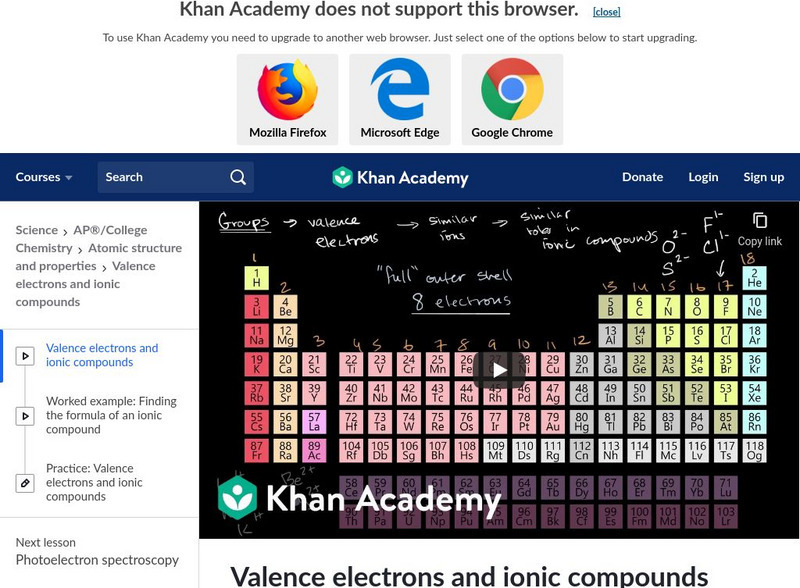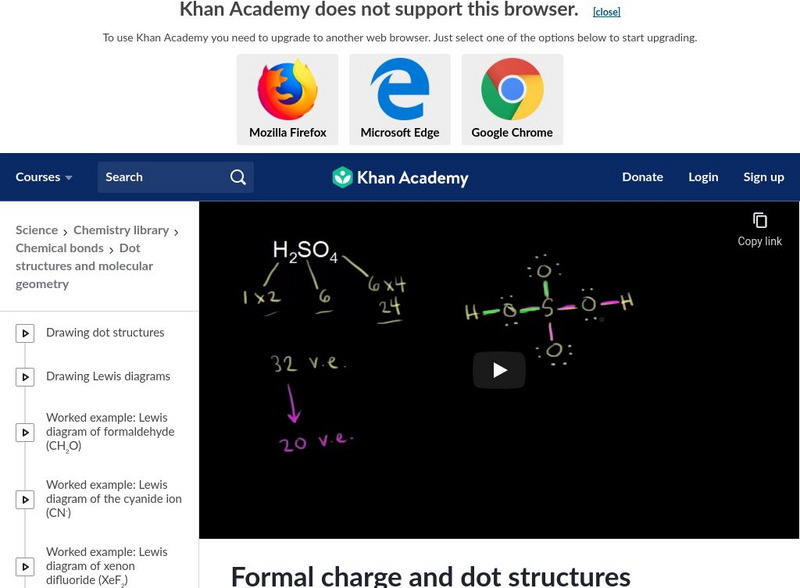Hi, what do you want to do?
Berkeley University of California
Covalent Bonding
You have a joke about covalent bonds? Do share! Discussing the difference in ionic and covalent bonding, the video focuses on electron sharing and molecular orbitals. Video is the third in a series of 15.
Berkeley University of California
Octet Rule
What did sodium say to chloride? You complete me! The video goes over the octet rule for bonding. It introduces the concept of double and triple bonds and references the electron dot structure and valence electrons. Video is the...
Crash Course
Bonding Models and Lewis Structures
Atomic models help us visualize the interactions of substances we cannot see. Explore atomic models, specifically Lewis structures, that show valence electrons and their role in bonds.
Crash Course
Atomic Hook-Ups - Types of Chemical Bonds
Atoms form relationships with other atoms, just like humans. Their relationships are called bonds and there are different types. Explore how energy is transferred between atoms through ionic and covalent bonds.
Crash Course
Redox Reactions
The breakdown of your breakfast and plants photosynthesizing all relate to the simple movement of electrons. Learn about the complex manner of redox reactions, where electrons move from one compound to another, changing and propelling...
Ricochet Science
Chemical Bonding - Ionic vs. Covalent Bonds
Demonstrate that all bonds are not made the same. Use the video to compare ionic and covalent bonds. Each bond is explained in depth using specific examples.
Ricochet Science
Polar Bonds and Hydrogen Bonds
Hydrogen bonds aren't your run-of-the mill bonds — they make life possible! Use the video to understand how hydrogen bonds form between water molecules.
Ricochet Science
Electronegativity
It's not just any old bond! Through electronegativity, the instructor in a science video explains polar and nonpolar covalent bonds.
Educreations
Covalent Bonds
Share this video with your class and explore the conditions that make covalent bonding possible. Examining the complex series of attractive and repulsive forces that exist between atoms, this video explains how at just the right...
Educreations
Types of Solids
Young chemists discover that all solids are not created equal with the help of this short instructional video. Taking a microscopic look at matter, students learn how to classify solids based on the type of bonds that are responsible for...
Educreations
Bond Types
Bond some basic chemistry knowledge to the brains of your students with this short instructional video. After first identifying metals and non-metals on the period table, the presenter continues on to explain the types of materials...
TED-Ed
Schrödinger's Cat: A Thought Experiment in Quantum Mechanics
Can something be both alive and dead at the same time? According to quantum physicist Erwin Schrödinger, the answer is yes. Watch this short video to learn how the wave and particle nature of all matter allows objects to be in two states...
Curated OER
Ionic and Covalent Bonding Animation
This nifty little presentation uses computer animation to illuminate how ionic molecular bonds and covalent bonds are formed. This would be a terrific addition to your PowerPoint or Smart Board lesson on molecular bonding.
Crash Course
That's Why Carbon Is A Tramp
Carbon bonds with one, two, or three atoms in order to gain four electrons and fill its outer shell. Here is a video that explores the chemistry aspects of biology through the lens of carbon. A review of Lewis dot structures begins the...
Berkeley University of California
Sulfate Bond Order (NB)
Sharing is caring in covalent bonds. The instructor details how to solve for bond order in covalent bonds using electron dot structures to find the formal charges.
Berkeley University of California
Formal Charge
Want to hear a joke about element 116? Uuh ... Here is a video that explains how to find the formal charge of a molecule using its covalent electron distribution. It focuses on electron dot structure and dividing the molecule into...
Berkeley University of California
Ionization Energy, Electron Affinity
What do dipoles say in passing? Have you got a moment? Videos begin with ionization energy, then move on to covalent bonds, polar-covalent bonds, and ionic bonds. After a discussion of dipole moments, a video quiz reviews the material....
Massachusetts Institute of Technology
Mit: Blossoms: Plastics and Covalent Chemical Bonds
Interactive video lesson discusses the distribution of electrons in a carbon atom, and then follows with a chemical investigation of plastics.
Khan Academy
Khan Academy: Valence Electrons and Bonding
An explanation of how the amount of electrons in the outermost shell of an atom designates the reactivity to other elements. [10:57]
Khan Academy
Khan Academy: Electronegativity and Bonding
Explanation of how differences in electronegativity effect chemical bonding. Bonds are classified by various bonding types.
Khan Academy
Khan Academy: Electronegativity
Learn the difference between electronegativity and electron affinity. Group and period trends are also discussed in relation to atomic radii. [9:54]
Khan Academy
Khan Academy: Electronegativity and Bonding
The Pauling Scale is used to understand bonding due to electronegativity. Bond types are classified. [11:39]
Khan Academy
Khan Academy: Covalent Networks, Metallic and Ionic Crystals
An introduction to the strongest molecular structures. [9:14]
Khan Academy
Khan Academy: Formal Charge and Dot Structures
An introduction of formal charge and how it may affect the stabilization of dot structures. [11:30]




























